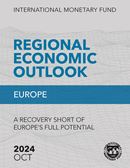This web page presents information about the work of the IMF in Serbia, including the activities of the IMF Resident Representative Office. Additional information can be found on the Serbia and IMF country page, including IMF reports and Executive Board documents that deal with Serbia.
IMF’s Work on Serbia
-
October 16, 2024
An International Monetary Fund (IMF) mission, led by Donal McGettigan, met with the Serbian authorities during October 3-15, 2024, to discuss performance under Serbia’s Stand-By Arrangement (SBA) and the authorities’ request for a successor 36-month Policy Coordination Instrument (PCI) that will run from December 2024 to December 2027
-
July 8, 2024
The Executive Board of the International Monetary Fund (IMF) concluded the Third Review Under the Stand-By Arrangement (SBA) for the Republic of Serbia. The SBA amounting to about SDR 1.89 billion, or approximately EUR 2.4 billion, was approved by the IMF’s Board on December 19, 2022 (see Press Release No. 22/447)
-
July 8, 2024
Series:Country Report No. 2024/202
-
March 26, 2024
An International Monetary Fund (IMF) mission, led by Donal McGettigan, held in-person meetings with the Serbian authorities during March 14-26, 2024 to discuss performance under Serbia’s Stand-By Arrangement
-
Executing a Soft Landing for a Lasting Recovery
March 15, 2024
Today’s gathering comes two years after Russia’s invasion of Ukraine, a subsequent energy-price roller coaster, and the advent of a more fragmented global economy. Against this backdrop Europe has done well, because governments acted fast and decisively. Unemployment rates have remained low, inflation has declined sharply, and the EU announced a new accession effort—stemming the tide of fragmentation.
Regional Economic Outlook
October 24, 2024
Europe’s economy is recovering, benefiting from a strong crises’ response. Yet, the recovery is falling short of its full potential. Uncertainty about persistent core inflation, policy directions, and geopolitical conflicts, is dampening the near-term outlook. In the longer term, perennially weak productivity growth—a result of limited scale and business dynamism–-amid new headwinds from fragmentation and climate change are holding back growth potential.
Read the Report




